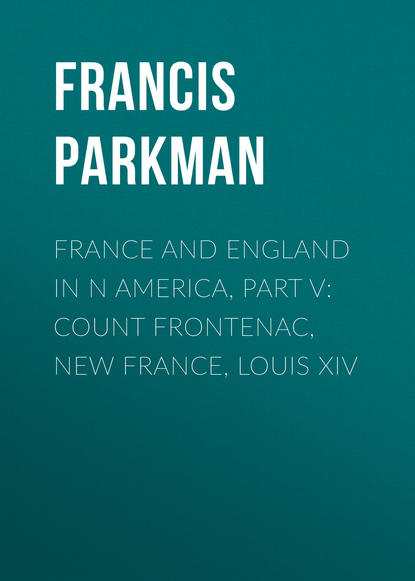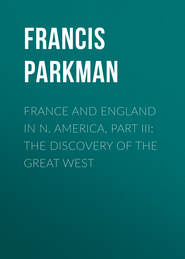По всем вопросам обращайтесь на: info@litportal.ru
(©) 2003-2024.
✖
France and England in N America, Part V: Count Frontenac, New France, Louis XIV
Настройки чтения
Размер шрифта
Высота строк
Поля
245
Thury, Relation du Combat des Canibas. Compare Hutchinson, Hist. Mass., I. 352, and Mather, Magnalia, II. 590 (ed. 1853). The murder of prisoners after the capitulation has been denied. Thury incidentally confirms the statement, when, after saying that he exhorted the Indians to refrain from drunkenness and cruelty, he adds that, in consequence, they did not take a single scalp, and "tuèrent sur le champ ceux qu'ils voulurent tuer."
English accounts place the number of Indians at from two to three hundred. Besides the persons taken in the fort, a considerable number were previously killed, or captured in the houses and fields. Those who were spared were carried to the Indian towns on the Penobscot, the seat of Thury's mission. La Motte-Cadillac, in his Mémoire sur l'Acadie, 1692, says that 80 persons in all were killed; an evident exaggeration. He adds that Weems and six men were spared at the request of the chief, Madockawando. The taking of Pemaquid is remarkable as one of the very rare instances in which Indians have captured a fortified place otherwise than by treachery or surprise. The exploit was undoubtedly due to French prompting. We shall see hereafter with what energy and success Thury incited his flock to war.
246
The archives of Massachusetts contain various papers on the disaster at Salmon Falls. Among them is the report of the authorities of Portsmouth to the governor and council at Boston, giving many particulars, and asking aid. They estimate the killed and captured at upwards of eighty, of whom about one fourth were men. They say that about twenty houses were burnt, and mention but one fort. The other, mentioned in the French accounts, was, probably a palisaded house. Speaking of the combat at the bridge, they say, "We fought as long as we could distinguish friend from foe. We lost two killed and six or seven wounded, one mortally." The French accounts say fourteen. This letter is accompanied by the examination of a French prisoner, taken the same day. Compare Mather, Magnalia, II. 595; Belknap, Hist. New Hampshire, I. 207; Journal of Rev. John Pike (Proceedings of Mass. Hist. Soc. 1875); and the French accounts of Monseignat and La Potherie. Charlevoix adds various embellishments, not to be found in the original sources. Later writers copy and improve upon him, until Hertel is pictured as charging the pursuers sword in hand, while the English fly in disorder before him.
247
Declaration of Sylvanus Davis; Mather, Magnalia, II. 603.
248
Relation de Monseignat; La Potherie, III. 79.
249
Their remains were buried by Captain Church, three years later.
On the capture of Fort Loyal, compare Monseignat and La Potherie with Mather, Magnalia, II. 603, and the Declaration of Sylvanus Davis, in 3 Mass. Hist. Coll., I. 101. Davis makes curious mistakes in regard to French names, his rustic ear not being accustomed to the accents of the Gallic tongue. He calls Courtemanche, Monsieur Corte de March, and Portneuf, Monsieur Burniffe or Burneffe. To these contemporary authorities may be added the account given by Le Clercq, Établissement de la Foy, II. 393, and a letter from Governor Bradstreet of Massachusetts to Jacob Leisler in Doc. Hist. N. Y., II. 259. The French writers of course say nothing of any violation of faith on the part of the victors, but they admit that the Indians kept most of the prisoners. Scarcely was the fort taken, when four English vessels appeared in the harbor, too late to save it. Willis, in his History of Portland (ed. 1865), gives a map of Fort Loyal and the neighboring country. In the Massachusetts archives is a letter from Davis, written a few days before the attack, complaining that his fort is in wretched condition.
250
I am unable to discover the foundation of this last charge.
251
The attacking party consisted of some of the Abenakis and Algonquins who had been with Hertel, and who had left the main body after the destruction of Salmon Falls. Several of them were killed in the skirmish, and among the rest their chief, Hopehood, or Wohawa, "that memorable tygre," as Cotton Mather calls him.
252
Summary of Muster Roll, appended to A Journal of the Expedition from Boston against Port Royal, among the papers of George Chalmers in the Library of Harvard College.
253
Relation de la Prise du Port Royal par les Anglois de Baston, pièce anonyme, 27 Mai, 1690.
254
Journal of the Expedition from Boston against Port Royal.
255
Ibid.
256
Relation de Monseignat. Nevertheless, a considerable number seem to have refused the oath, and to have been pillaged. The Relation de la Prise du Port Royal par les Anglois de Baston, written on the spot immediately after the event, says that, except that nobody was killed, the place was treated as if taken by assault. Meneval also says that the inhabitants were pillaged. Meneval au Ministre, 29 Mai, 1690; also Rapport de Champigny, Oct., 1690. Meneval describes the New England men as excessively irritated at the late slaughter of settlers at Salmon Falls and elsewhere.
257
Journal of the Expedition, etc.
258
An Account of the Silver and Effects which Mr. Phips keeps back from Mr. Meneval, in 3 Mass. Hist. Coll., I. 115.
Monseignat and La Potherie describe briefly this expedition against Port Royal. In the archives of Massachusetts are various papers concerning it, among which are Governor Bradstreet's instructions to Phips, and a complete invoice of the plunder. Extracts will be found in Professor Bowen's Life of Phips, in Sparks's American Biography, VII. There is also an order of council, "Whereas the French soldiers lately brought to this place from Port Royal did surrender on capitulation," they shall be set at liberty. Meneval, Lettre au Ministre, 29 Mai, 1690, says that there was a capitulation, and that Phips broke it. Perrot, former governor of Acadia, accuses both Meneval and the priest Petit of being in collusion with the English. Perrot à de Chevry, 2 Juin, 1690. The same charge is made as regards Petit in Mémoire sur l'Acadie, 1691.
Charlevoix's account of this affair is inaccurate. He ascribes to Phips acts which took place weeks after his return, such as the capture of Chedabucto.
259
Mémoire présenté à M. de Ponchartrain par M. de Meneval, 6 Avril, 1691.
260
This note, dated 7 Jan., 1691, is cited by Bowen in his Life of Phips, Sparks's American Biography, VII.
261
Mémoire de Meneval.
262
Ibid.
263
An excellent account of Phips will be found in Professor Bowen's biographical notice, already cited. His Life by Cotton Mather is excessively eulogistic.
264
Bradstreet and Council to the Earl of Shrewsbury, 29 Mar., 1690; Danforth to Sir H. Ashurst, 1 April, 1690.
265
Mass. Colonial Records, 12 Mar., 1690; Mather, Life of Phips.
266
Proposals for an Expedition against Canada, in 3 Mass. Hist. Coll., X. 119.
267
Rev. John Emerson to Wait Winthrop, 26 July, 1690. Emerson was the minister of Gloucester. He begs for the release of the impressed men.











